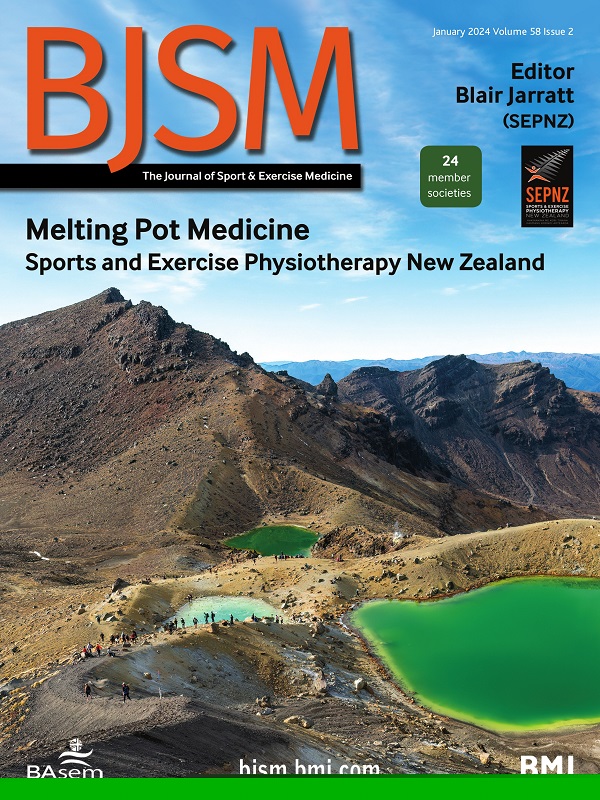Contemporary reporting in sports injury epidemiology: choosing words carefully and considering a Holistic Injury Impact Framework
IF 11.6
1区 医学
Q1 SPORT SCIENCES
引用次数: 0
Abstract
In recent years, there has been a noticeable amount of discussion surrounding reporting methods in sports injury epidemiology.1–3 Particular emphasis has been placed on characterising the scope of impact that an injury poses in various sporting contexts. Depicting the extent of an injury problem using specific metrics can be complex and challenging. While movements towards comprehensive reporting are important, it is equally vital to consider the inherent characteristics of the metrics and measures reported in epidemiological studies. These considerations influence how general consumers understand the information and how medical professionals perceive and respond to the broader implications of sports-related injuries. The aim of this article is to critically examine the complexities surrounding summary metrics used to represent injury sequelae in sports injury epidemiology and to advocate for nuanced approaches to conceptualising and reporting the impact of sport-related injuries. Various methods have been used to describe the epidemiological features of injuries and to evaluate the efficacy of injury prevention measures.4–6 In efforts to describe injury sequelae, measures such as severity and injury burden are frequently employed alongside the calculation of injury incidence rates.3 While the authors herein endorse using various metrics to comprehensively illustrate the scope of injury issues, we advocate for thoroughly considering the inferential implications of the reported measures to provide a clear and multifaceted understanding, particularly for clinicians. Historically, reporting injury severity—often equated with time loss—has been a mainstay in sports injury research.7–9 Similarly, there has been a recent surge in the reporting of injury burden, typically quantified as the product of the injury incidence rate and average time loss.10 Disregarding the mathematical intricacies of calculating these measures, it is pertinent to acknowledge that metrics such as ‘severity’ and ‘burden’ represent latent or unobserved constructs. Therefore, while it may be convenient to enumerate …当代运动损伤流行病学报道:谨慎选择词汇,考虑整体损伤影响框架
近年来,围绕运动损伤流行病学的报告方法进行了大量的讨论。1-3特别强调的是在不同的运动环境下,损伤所造成的影响范围。使用特定的指标来描述受伤问题的程度可能是复杂和具有挑战性的。虽然朝着全面报告的方向发展很重要,但同样重要的是要考虑流行病学研究中报告的指标和措施的固有特征。这些因素影响了普通消费者如何理解信息,以及医疗专业人员如何感知和应对运动相关损伤的更广泛影响。本文的目的是批判性地研究运动损伤流行病学中用于表示损伤后遗症的汇总指标的复杂性,并倡导采用细致入微的方法来概念化和报告运动相关损伤的影响。各种方法被用来描述伤害的流行病学特征和评估伤害预防措施的效果。在努力描述伤害后遗症时,在计算伤害发生率的同时,经常采用严重程度和伤害负担等措施虽然作者在此赞同使用各种指标来全面说明损伤问题的范围,但我们主张彻底考虑所报道的措施的推论意义,以提供一个清晰和多方面的理解,特别是对临床医生。从历史上看,报告损伤严重程度——通常等同于时间损失——一直是运动损伤研究的主要内容。7-9同样,最近关于伤害负担的报告激增,通常以伤害发生率和平均时间损失的乘积来量化忽略计算这些度量的数学复杂性,承认诸如“严重性”和“负担”之类的度量代表潜在的或未观察到的构造是相关的。因此,虽然列举……可能比较方便。
本文章由计算机程序翻译,如有差异,请以英文原文为准。
求助全文
约1分钟内获得全文
求助全文
来源期刊
CiteScore
27.10
自引率
4.90%
发文量
217
审稿时长
3-8 weeks
期刊介绍:
The British Journal of Sports Medicine (BJSM) is a dynamic platform that presents groundbreaking research, thought-provoking reviews, and meaningful discussions on sport and exercise medicine. Our focus encompasses various clinically-relevant aspects such as physiotherapy, physical therapy, and rehabilitation. With an aim to foster innovation, education, and knowledge translation, we strive to bridge the gap between research and practical implementation in the field. Our multi-media approach, including web, print, video, and audio resources, along with our active presence on social media, connects a global community of healthcare professionals dedicated to treating active individuals.

 求助内容:
求助内容: 应助结果提醒方式:
应助结果提醒方式:


